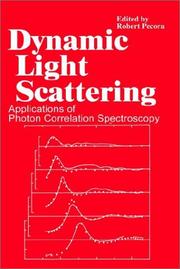| Listing 1 - 7 of 7 |
Sort by
|

ISBN: 0306417901 Year: 1985 Publisher: New York
Abstract | Keywords | Export | Availability | Bookmark
 Loading...
Loading...Choose an application
- Reference Manager
- EndNote
- RefWorks (Direct export to RefWorks)

ISBN: 1402044658 140204464X 1402082908 Year: 2008 Publisher: Dordrecht : Springer Netherlands : Imprint: Springer,
Abstract | Keywords | Export | Availability | Bookmark
 Loading...
Loading...Choose an application
- Reference Manager
- EndNote
- RefWorks (Direct export to RefWorks)
Progress in basic soft matter research is driven largely by the experimental techniques available. Much of the work is concerned with understanding them at the microscopic level, especially at the nanometer length scales that give soft matter studies a wide overlap with nanotechnology. This 2 volume reference work, split into 4 parts, presents detailed discussions of many of the major techniques commonly used as well as some of those in current development for studying and manipulating soft matter. The articles are intended to be accessible to the interdisciplinary audience (at the graduate student level and above) that is or will be engaged in soft matter studies or those in other disciplines who wish to view some of the research methods in this fascinating field. Part 1 contains articles with a largely (but, in most cases, not exclusively) theoretical content and/or that cover material relevant to more than one of the techniques covered in subsequent volumes. It includes an introductory chapter on some of the time and space-time correlation functions that are extensively employed in other articles in the series, a comprehensive treatment of integrated intensity (static) light scattering from macromolecular solutions, as well as articles on small angle scattering from micelles and scattering from brush copolymers. A chapter on block copolymers reviews the theory (random phase approximation) of these systems, and surveys experiments on them (including static and dynamic light scattering, small-angle x-ray and neutron scattering as well as neutron spin echo (NSE) experiments). This chapter describes block copolymer behavior in the "disordered phase" and also their self-organization. The volume concludes with a review of the theory and computer simulations of polyelectrolyte solutions. Part 2 contains material on dynamic light scattering, light scattering in shear fields and the related techniques of fluorescence recovery after photo bleaching (also called fluorescence photo bleaching recovery to avoid the unappealing acronym of the usual name), fluorescence fluctuation spectroscopy, and forced Rayleigh scattering. Volume 11 concludes with an extensive treatment of light scattering from dispersions of polysaccharides. Part 3 presents articles devoted to the use of x-rays and neutrons to study soft matter systems. It contains survey articles on both neutron and x-ray methods and more detailed articles on the study of specific systems- gels, melts, surfaces, polyelectrolytes, proteins, nucleic acids, block copolymers. It includes an article on the emerging x-ray photon correlation technique, the x-ray analogue to dynamic light scattering (photon correlation spectroscopy). Part 4 describes direct imaging techniques and methods for manipulating soft matter systems. It includes discussions of electron microscopy techniques, atomic force microscopy, single molecule microscopy, optical tweezers (with applications to the study of DNA, myosin motors, etc.), visualizing molecules at interfaces, advances in high contrast optical microscopy (with applications to imaging giant vesicles and motile cells), and methods for synthesizing and atomic force microscopy imaging of novel highly branched polymers.. Soft matter research is, like most modern scientific work, an international endeavor. This is reflected by the contributions to these volumes by leaders in the field from laboratories in nine different counties. An important contribution to the international flavor of the field comes, in particular, from x-ray and neutron experiments that commonly involve the use of a few large facilities that are multinational in their staff and user base.
Soft condensed matter. --- Condensed matter. --- Condensed materials --- Condensed media --- Condensed phase --- Materials, Condensed --- Media, Condensed --- Phase, Condensed --- Liquids --- Matter --- Solids --- Condensed matter --- Matter, Soft (Condensed matter) --- Matter, Soft condensed --- Soft matter (Condensed matter) --- Complex fluids --- Surfaces (Physics). --- Polymers. --- Nanotechnology. --- Soft and Granular Matter, Complex Fluids and Microfluidics. --- Characterization and Evaluation of Materials. --- Polymer Sciences. --- Biological and Medical Physics, Biophysics. --- Molecular technology --- Nanoscale technology --- High technology --- Polymere --- Polymeride --- Polymers and polymerization --- Macromolecules --- Physics --- Surface chemistry --- Surfaces (Technology) --- Surfaces (Physics) --- Amorphous substances. --- Complex fluids. --- Materials science. --- Polymers . --- Biophysics. --- Biological physics. --- Biological physics --- Biology --- Medical sciences --- Material science --- Physical sciences --- Complex liquids --- Fluids, Complex --- Amorphous substances --- Soft condensed matter --- Materials --- Soft and Granular Matter. --- Characterization and Analytical Technique. --- Analysis.

ISBN: 1402005024 1402005016 9401004420 Year: 2002 Publisher: Dordrecht : Kluwer,
Abstract | Keywords | Export | Availability | Bookmark
 Loading...
Loading...Choose an application
- Reference Manager
- EndNote
- RefWorks (Direct export to RefWorks)
This volume is based on lectures given at the NATO-Advanced Study Institute on Structure and Dynamics of Polymer and Colloid Systems held in Les Houches, France from September 14-24, 1999. The meeting arose from a perceived need to bring together scientists studying the polymer and colloid fields. Although these fields are intertwined and share many techniques (e. g. , light, neutron and x-ray scattering), it is remarkable how little the approaches and concepts used by the one field penetrate the other. For instance, the theory of spherical colloids is very highly developed and many of the concepts developed for these systems can be extended to those with non-spherical morphology, such as solutions of rigid rod polymers. In addition, mixtures of polymers and colloids, both in the bulk and at interfaces, are the basis for many industrial products. Methods are now rapidly being developed for understanding the structure and dynamics in polymer/colloid mixtures at the molecular level, but the point of view of the colloid scientist is often rather different from that of the polymer scientist. The NATO-ASI brought together polymer and colloid scientists, including many young researchers, who presented and discussed recent developments in these fields and the possibilities for cross-fertilization This volume contains articles on a wide variety of topics at the research forefront of the polymer and colloid fields by some of the world's foremost experts at a level accessible to graduate students, post-docs and researchers.
Polymers --- Congresses --- Colloids --- Physical chemistry. --- Materials science. --- Polymers . --- Condensed matter. --- Physical Chemistry. --- Characterization and Evaluation of Materials. --- Polymer Sciences. --- Condensed Matter Physics. --- Condensed materials --- Condensed media --- Condensed phase --- Materials, Condensed --- Media, Condensed --- Phase, Condensed --- Liquids --- Matter --- Solids --- Polymere --- Polymeride --- Polymers and polymerization --- Macromolecules --- Material science --- Physical sciences --- Chemistry, Theoretical --- Physical chemistry --- Theoretical chemistry --- Chemistry --- Polymères --- Polymères --- Colloides

ISBN: 9781402044656 9781402044649 Year: 2008 Publisher: Dordrecht Springer Netherlands
Abstract | Keywords | Export | Availability | Bookmark
 Loading...
Loading...Choose an application
- Reference Manager
- EndNote
- RefWorks (Direct export to RefWorks)
Fluid mechanics --- Macromolecules --- General biophysics --- Materials sciences --- Electrical engineering --- materiaalkennis --- materie (fysica) --- biofysica --- nanotechniek --- polymeren --- moleculaire biologie --- fysicochemie --- vloeistoffen

ISBN: 0486411559 9780486411552 Year: 2000 Publisher: Mineola Dover
Abstract | Keywords | Export | Availability | Bookmark
 Loading...
Loading...Choose an application
- Reference Manager
- EndNote
- RefWorks (Direct export to RefWorks)
Light --- Molecules --- Lumière --- Molécules --- Scattering --- Diffusion --- Molecules. --- Scattering. --- -Molecules --- 535.36 --- 535.36 Light scattering. Diffusion --- Light scattering. Diffusion --- Electromagnetic waves --- Light sources --- Spectrum analysis --- Lumière --- Molécules --- Light scattering --- Scattering of light --- Particles --- Reflection (Optics) --- Refraction --- Scattering (Physics)
Book
ISBN: 0471071005 Year: 1976 Publisher: New York (N.Y.) Wiley
Abstract | Keywords | Export | Availability | Bookmark
 Loading...
Loading...Choose an application
- Reference Manager
- EndNote
- RefWorks (Direct export to RefWorks)
Light --- Molecules --- 535.36 --- 535.36 Light scattering. Diffusion --- Light scattering. Diffusion --- Light scattering --- Scattering of light --- Diffusion --- Particles --- Reflection (Optics) --- Refraction --- Scattering (Physics) --- Scattering --- Laboratory techniques in physics --- Theoretical spectroscopy. Spectroscopic techniques --- Biological techniques --- fysicochemie

ISBN: 9781402044656 9781402044649 Year: 2008 Publisher: Dordrecht Springer Netherlands
Abstract | Keywords | Export | Availability | Bookmark
 Loading...
Loading...Choose an application
- Reference Manager
- EndNote
- RefWorks (Direct export to RefWorks)
Progress in basic soft matter research is driven largely by the experimental techniques available. Much of the work is concerned with understanding them at the microscopic level, especially at the nanometer length scales that give soft matter studies a wide overlap with nanotechnology. This 2 volume reference work, split into 4 parts, presents detailed discussions of many of the major techniques commonly used as well as some of those in current development for studying and manipulating soft matter. The articles are intended to be accessible to the interdisciplinary audience (at the graduate student level and above) that is or will be engaged in soft matter studies or those in other disciplines who wish to view some of the research methods in this fascinating field. Part 1 contains articles with a largely (but, in most cases, not exclusively) theoretical content and/or that cover material relevant to more than one of the techniques covered in subsequent volumes. It includes an introductory chapter on some of the time and space-time correlation functions that are extensively employed in other articles in the series, a comprehensive treatment of integrated intensity (static) light scattering from macromolecular solutions, as well as articles on small angle scattering from micelles and scattering from brush copolymers. A chapter on block copolymers reviews the theory (random phase approximation) of these systems, and surveys experiments on them (including static and dynamic light scattering, small-angle x-ray and neutron scattering as well as neutron spin echo (NSE) experiments). This chapter describes block copolymer behavior in the "disordered phase" and also their self-organization. The volume concludes with a review of the theory and computer simulations of polyelectrolyte solutions. Part 2 contains material on dynamic light scattering, light scattering in shear fields and the related techniques of fluorescence recovery after photo bleaching (also called fluorescence photo bleaching recovery to avoid the unappealing acronym of the usual name), fluorescence fluctuation spectroscopy, and forced Rayleigh scattering. Volume 11 concludes with an extensive treatment of light scattering from dispersions of polysaccharides. Part 3 presents articles devoted to the use of x-rays and neutrons to study soft matter systems. It contains survey articles on both neutron and x-ray methods and more detailed articles on the study of specific systems- gels, melts, surfaces, polyelectrolytes, proteins, nucleic acids, block copolymers. It includes an article on the emerging x-ray photon correlation technique, the x-ray analogue to dynamic light scattering (photon correlation spectroscopy). Part 4 describes direct imaging techniques and methods for manipulating soft matter systems. It includes discussions of electron microscopy techniques, atomic force microscopy, single molecule microscopy, optical tweezers (with applications to the study of DNA, myosin motors, etc.), visualizing molecules at interfaces, advances in high contrast optical microscopy (with applications to imaging giant vesicles and motile cells), and methods for synthesizing and atomic force microscopy imaging of novel highly branched polymers.. Soft matter research is, like most modern scientific work, an international endeavor. This is reflected by the contributions to these volumes by leaders in the field from laboratories in nine different counties. An important contribution to the international flavor of the field comes, in particular, from x-ray and neutron experiments that commonly involve the use of a few large facilities that are multinational in their staff and user base.
Fluid mechanics --- Macromolecules --- General biophysics --- Materials sciences --- Electrical engineering --- materiaalkennis --- materie (fysica) --- biofysica --- nanotechniek --- polymeren --- moleculaire biologie --- fysicochemie --- vloeistoffen
| Listing 1 - 7 of 7 |
Sort by
|

 Search
Search Feedback
Feedback About UniCat
About UniCat  Help
Help News
News